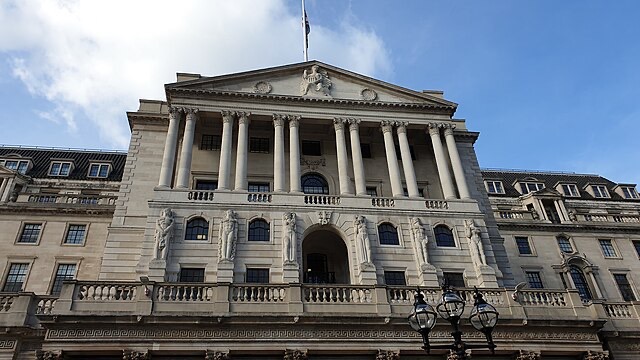Economists predict pause in rate-cutting cycle amid unexpected rise in inflation to 3.5%
Labour market shows signs of weakness as wage growth slows and unemployment rises
Trump tariff concerns and geopolitical tensions add to monetary policy challenges
MPC has followed pattern of cutting rates at alternating meetings since August 2024
UK interest rates are expected to remain unchanged at 4.25% this week, as policymakers weigh up conflicting economic signals at home and abroad.
Most forecasters believe the Bank of England’s Monetary Policy Committee (MPC) will hold interest rates steady when it meets on Thursday, pausing its gradual rate-cutting cycle amid ongoing uncertainty.
The MPC has voted to reduce rates at alternating meetings since last August, when it began easing from a peak of 5.25%. The central bank cut rates most recently in May, when a divided committee voted 5-4 to reduce the base rate from 4.5% to 4.25%.
INFLATION SURPRISES
Fresh data from the Office for National Statistics (ONS) revealed that inflation unexpectedly rose in April, complicating the Bank’s decision-making process.
The Consumer Prices Index (CPI) rose to 3.5% in April, up from 2.6% the month before – well above the Bank’s 2% target. The ONS later confirmed that an error in vehicle tax data meant the figure should have been slightly lower at 3.4%, though the official figure was not revised in line with ONS policy.
The Bank of England’s own forecasts, published in May, predict inflation will rise temporarily to 3.7% by the third quarter of 2025, partly due to higher energy prices, before falling back towards the target.
Ellie Henderson, an economist at Investec, said monetary policy appeared to be “in a good position” and gave the Bank flexibility to respond as conditions evolve.
“Ultimately, this is a highly uncertain time that requires a potentially nimble response from central banks, limiting any great foresight,” Henderson said. “Although the June decision might seem clear cut, how the MPC responds to the evolving economic backdrop thereafter much depends on the details of the world in which we find ourselves.”
LABOUR MARKET WEAKENING
New UK labour market data has shown signs of weakness, potentially supporting the case for future rate cuts. Wage growth slowed in the three months to April, and unemployment rose as businesses faced ongoing cost pressures.
The Bank of England expects private sector regular pay growth to fall to around 3.75% by the end of 2025, down from current levels that remain uncomfortably high for achieving the inflation target sustainably.
Rob Wood and Elliott Jordan-Doak, economists at Pantheon Macroeconomics, said the softer labour market “will reassure the MPC that it can plan on further rate cuts”, but added: “One month’s data is far from enough to allow the MPC to bin its ‘gradual and careful’ approach to easing monetary policy.
TRUMP TARIFF UNCERTAINTY
Markets have been rattled by fresh geopolitical and economic developments, particularly concerns around President Donald Trump’s proposed tariffs, which analysts say have weighed on exports and dampened business confidence.
Bank of England Governor Andrew Bailey recently told MPs that the pace and extent of rate cuts was “now shrouded in a lot more uncertainty” thanks to global trade disruption.
The Bank currently believes Trump’s tariffs will reduce global economic activity, lowering export prices and inflation. However, Bailey acknowledged this view is “open to interpretation” – if tariffs disrupt supply chains, that could prove inflationary instead.
The past few weeks have shown how unpredictable the global economy can be. That’s why we need to stick to a gradual and careful approach to further rate cuts,” Bailey said after the May decision.
DIVIDED COMMITTEE
The MPC remains fairly divided on the appropriate path for monetary policy. At the May meeting, five members voted for a quarter-point cut, while two wanted rates held at 4.5% and two others preferred a larger half-point reduction to 4%.
Key hawks on the committee, including Chief Economist Huw Pill and external member Catherine Mann, have expressed concerns about labour market strength and the risk that higher pay rises have become culturally engrained following recent years of high inflation.
Pill worries that workers may continue to expect bigger pay rises even as resource pressures and the labour market ease – a dynamic that could keep inflation elevated.
MARKET EXPECTATIONS
Financial markets are currently pricing in around two further rate cuts this year, which would bring the base rate to 3.75% by year-end. This represents a scaling back from previous expectations of three cuts in 2025.
The average two-year fixed mortgage rate currently stands at 5.13%, while the average five-year deal is 5.10%, according to data from June 10.
Major banks have adjusted their forecasts following the higher-than-expected inflation data. Barclays no longer expects a June cut and now predicts the base rate will drop to 3.5% by February 2026, rather than by the end of 2025 as previously forecast.
GRADUAL APPROACH
The MPC has been clear about its intention to stick to a “gradual and careful approach” with interest rates, which many interpret as meaning quarterly cuts at most.
Bailey refused to make a prediction on the outcome of the upcoming rates meeting when speaking to MPs, though he emphasised that “interest rates are not on autopilot.
“Instead, the MPC must continue to respond carefully to the evolving economic circumstances,” he said.
LOOKING AHEAD
The Bank of England’s next MPC meeting results will be announced on Thursday, June 19. Subsequent meetings are scheduled for August 7 and September 18.
While economists are divided on the exact path of interest rates later this year, most agree that the combination of sticky inflation, global uncertainty, and the Bank’s cautious approach makes a June cut unlikely.
As one analyst put it: “The Bank of England has consistently shown it prefers to move cautiously when faced with uncertainty – and there’s plenty of that around at the moment.



